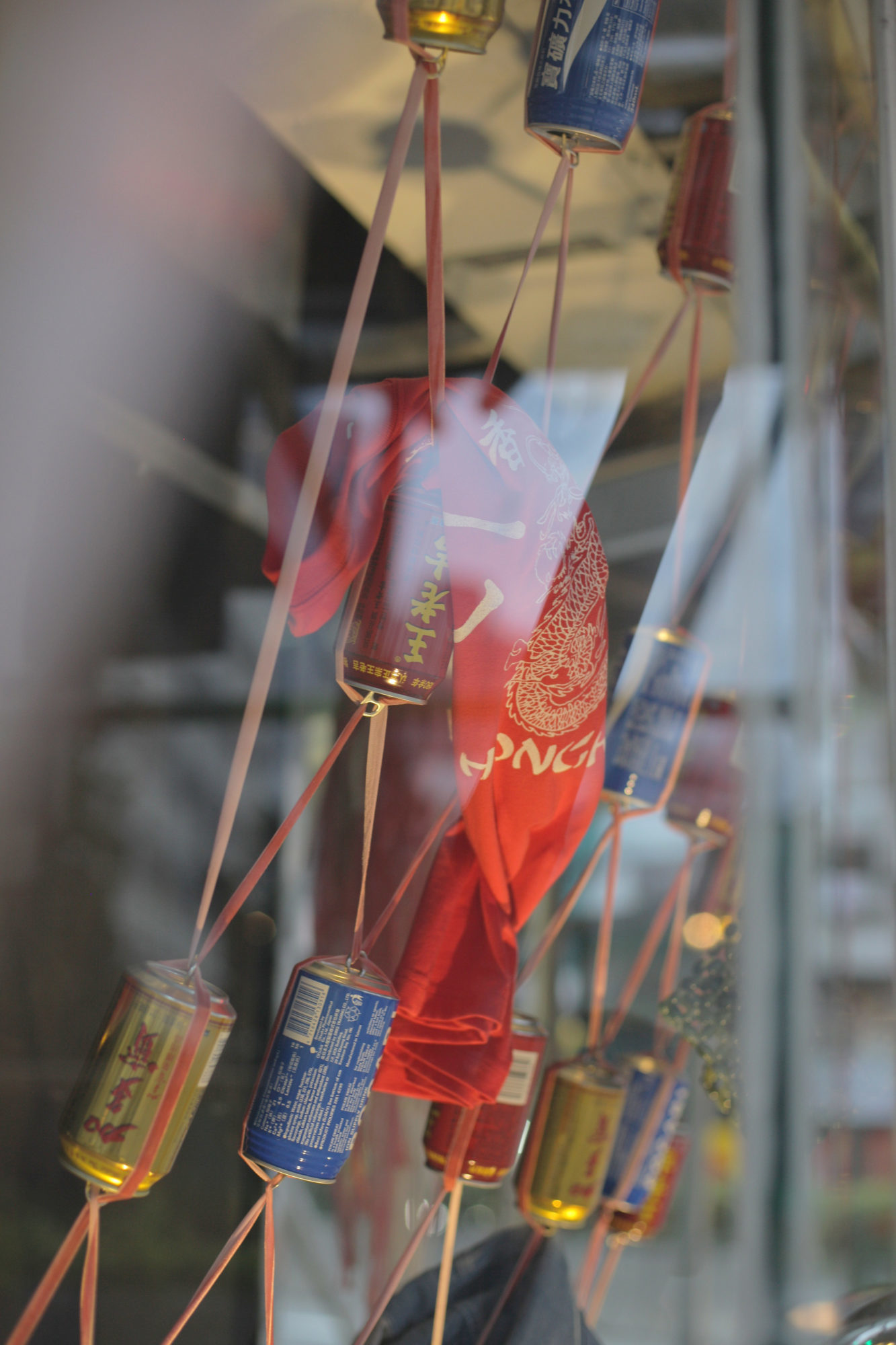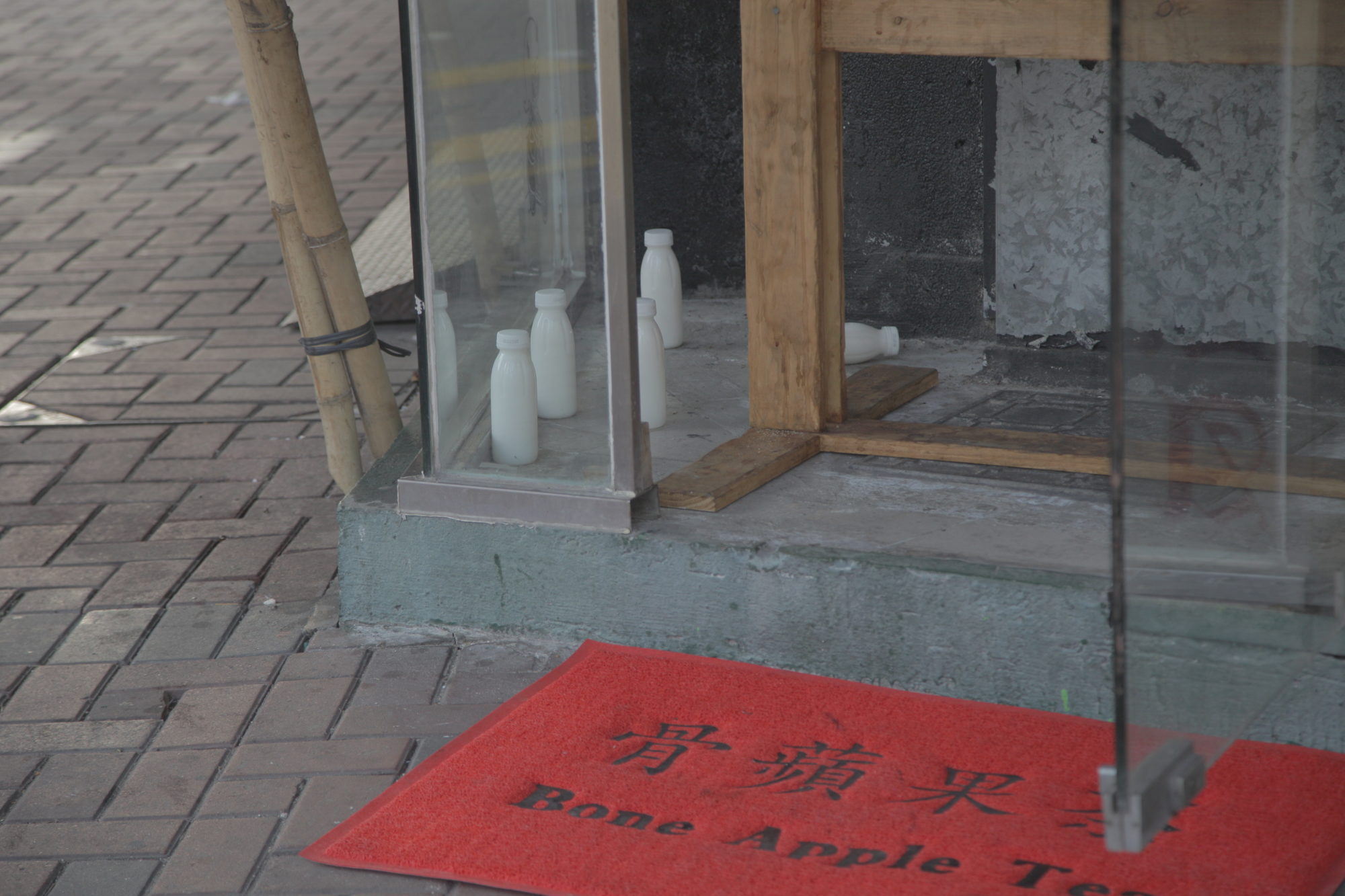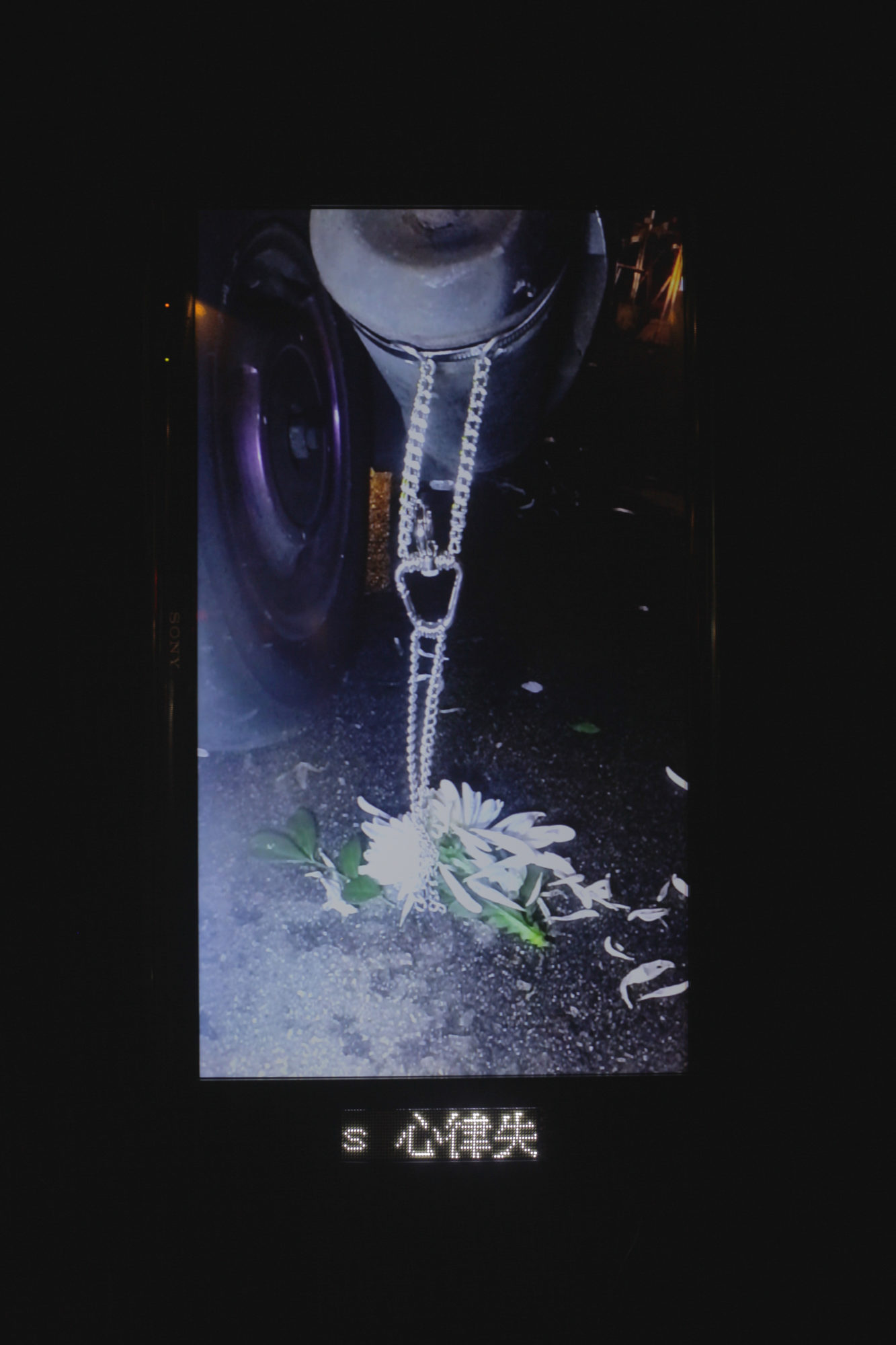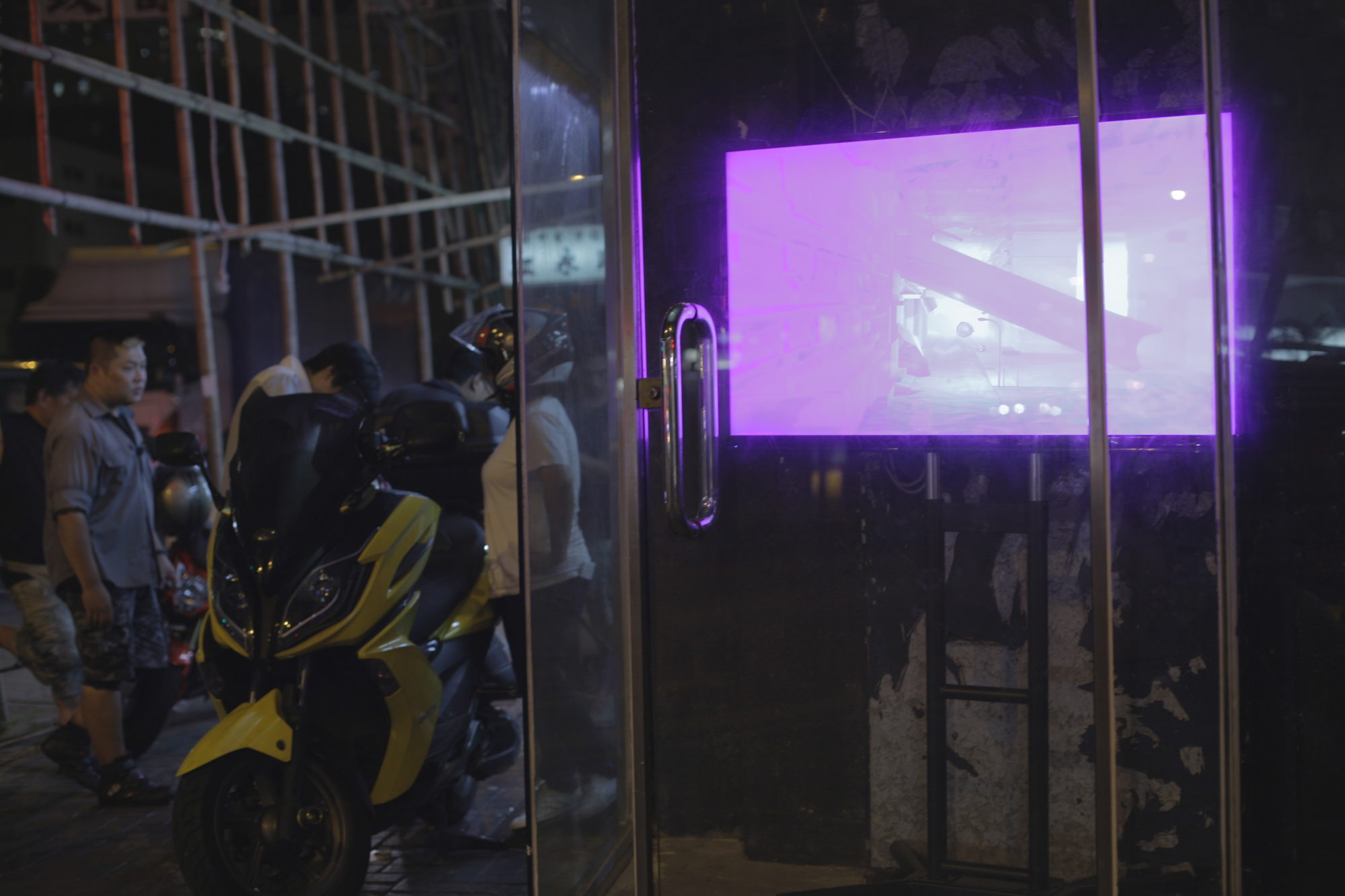Gray Harbor
Share:
Shui huo (水貨), “water goods,” the colloquial name for bootlegs or counterfeit items, may refer specifically to the technique of covertly throwing goods off ocean liners into the harbor so as to evade import tax. Ships arriving considerably lighter skirt costly tariffs, while hired hands swim out to retrieve the undeclared cargo. This alleged moonlit relay illuminates the texture of modern logistics, dispensing with its glossy patina. What such water goods reveal—only to persons close enough to smell the clinging dregs of seaweed or willing to caress the faux-leather handbag tucked into a cellophane sleeve—are the sentient negotiations of supple conquest. The logistical apparatus is shadowed, and indeed often supported, by a series of gray encounters.
- Plastic ribbons, Wong Lo Kat Tea and Pocari Sweat cans, bamboo scaffolding
Display Distribute featuring Bruno Zhu and Yat Pit
Traveling from sea to sand, from high-end to lowbrow, shui huo are boundary objects that cut across zones of legality and legitimacy with finesse. What might be read as “fake” by one, is simply a matter of “making-do” by another—and so shui huo carve a discursive route along which objects of indeterminate provenance drift, forging a necessarily meandering path. A surfeit of water goods perform subtle acts of space-taking—unseen, and yet in plain sight—their constant edging reveals the rhetoric of authenticity to be an effective mechanism for plotting points that subtly demarcate territory.
If the smooth transmission of goods requires agile acts of translation—from the unquantifiable to manageable units of economy—a rogue translation would contemplate a batch of counterfeit Hello Kitty umbrellas delivered to a makeshift stall on Canton Road, or several glinting sheaths of 0.3mm-thick glass just arrived to the phone repair store in Chungking Mansions, as more than matter. They animate the otherwise limp, sub-par, or surplus, which are the peripatetic narratives and scaffolding that surround them.
- Milk bottle, wooden guillotine
Sydney Shen
For the hundreds who to-and-fro daily through Hong Kong’s viscous borders, that “shopping mall with an airport attached” is not so much innuendo as matter-of-fact. Peddling products from across the tracks is both lifestyle and necessity for people on Individual Visit Permits from the People’s Republic of China, as well as their counterparts bearing Home Return Permits from the other side. The trauma of tainted milk brought to light by the 2008 powdered milk scandal, in which melamine was used as a protein replacement in infant formula, created widespread mistrust of the Chinese milk industry. Every weekend, four-wheeled suitcases packed with imported powder migrate in droves northward to China from the Special Administrative Region amid profiteering upon persistent fears. Although the skyline of Hong Kong is often emblematized as a silhouette of hypercapitalism, such gray-scale activities suggest not only capital’s effects but also the ways in which parallel markets surface. They are the veins that pulse vivaciously through, evasively sustain, and bring life to otherwise flailing life forms. They resemble a nimble “third nature” that thrives in spite of regulated capitalist enterprise.1
- Imitation silver chain necklace, chrysanthemums, a scooter, scrolling LED sign
Rob Chavasse
The dense petals of the chrysanthemum appear widely in funeral arrangements as symbols of grieving. The buds are also routinely steeped in hot water—chrysanthemum tea was popularized during the Song Dynasty (960–1279). Later, with the introduction of the consoo fund in the mid-18th century, tea entered another value system. A special tax levied on every picul of tea traded in the Pearl River Delta, the consoo was used to pay any extraneous expenses that merchants might incur—which indeed included gifts for trade superiors. Its name deriving from the hall where hong merchants met to discuss trade matters, the consoo tax was initially met with rebuke.2 But traders soon realized the necessity of such a system, which in particular served as a layer of protection from the fickle peculiarities of water-based trade. As one of the first taxes to be placed on goods themselves rather than on merchants, goods could in turn be taxed at different rates individually. In effect this differentiation set up a financial cushioning system for trade to develop according to wares rather than merchants. Cloaking teas in a plethora of figures allowed flows of goods and capital to change with the tides as necessary.
- Shimmering purples, Honda PCX scooter
Zheng Mahler
The throughput of the port of Hong Kong is in decline. A sloping graph shows a steady (40-million-ton) decrease in cargo between 1998 and 2016, the result of better automation and levying of cabotage elsewhere on the mainland, mixed with the growing uncertainty in general about the future of global trade. But few lament the slow recession of ocean freighters and brightly colored yet innocuous containers that speckle the coast with Tetris-grids. This geography has failed to captivate with the same imaginary that once attended romantic tales of seafaring pasts. But real-estate investors are fervently watching—counting square meters, the distance between train lines, roads, walkways, and ocean vistas—and already plotting what this history, rebranded and commandeered, might look like. Quantified units of cargo become quality units of dwelling, rendering the difference between porous beings and their contained counterparts obsolete. The sea will be packaged from fixed viewpoints rather than through drifting portholes, as commodity imports beget luxury accommodations. Reclaimed lifestyle on reclaimed land: ironically, this outcome may not be the long sought-after homecoming reunion with an alienated landscape. And so it may become relevant to ask: what are our port mythologies?
This feature originally appeared in ART PAPERS “Ports of Call,” Summer 2018.
Holy Motors is a series of vignettes—about a city as observed through the display window of a motorbike mechanic in Kowloon, Hong Kong over 2016-2017—organized by Luke Casey, Ming Lin, and Will Davis.
References
| ↑1 | In The Mushroom at the End of the World, Anna Tsing describes peri-capitalism as the smaller-scale enterprises that form the noncapitalist elements upon which capitalism depends, thus existing not at odds with capitalism but demonstrating its diversity. A third nature is: “What manages to live despite capitalism.” Anna Tsing, The Mushroom at the End of the World: On the Possibility of Life in Capitalist Ruins (Princeton: Princeton University Press, 2015), 66, viii. |
|---|---|
| ↑2 | Paul A. Van Dyke, Merchants of Canton and Macao: Politics and Strategies in Eighteenth-Century Chinese Trade (Hong Kong University Press, 2011), 29. |



